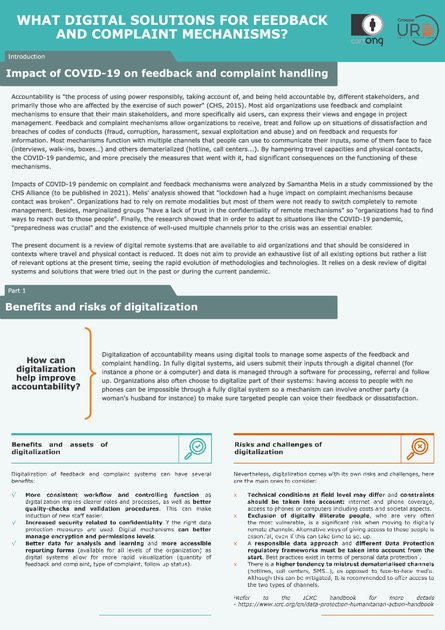
This resource was originally published on the CartoBlog in 2021 by CartONG. It was transferred to the IM Resource Portal in May 2021. The CartoBlog will be decommissioned in early 2022.
The compilation of this resource was led by Groupe URD, as part of its support to CartONG in the framework of the current project.
Accountability is “the process of using power responsibly, taking account of, and being held accountable by, different stakeholders, and primarily those who are affected by the exercise of such power” (CHS, 2015). Most aid organizations use feedback and complaint mechanisms to ensure that their main stakeholders, and more specifically aid users, can express their views and engage in project management. Feedback and complaint mechanisms allow organizations to receive, treat and follow up on situations of dissatisfaction and breaches of codes of conducts (fraud, corruption, harassment, sexual exploitation and abuse) and on feedback and requests for information. Most mechanisms function with multiple channels that people can use to communicate their inputs, some of them face to face (interviews, walk-ins, boxes…) and others dematerialized (hotline, call centers…). By hampering travel capacities and physical contacts, the COVID-19 pandemic, and more precisely the measures that went with it, had significant consequences on the functioning of these mechanisms.
Impacts of COVID-19 pandemic on complaint and feedback mechanisms were analyzed by Samantha Melis in a study commissioned by the CHS Alliance (to be published in 2021). Melis’ analysis showed that “lockdown had a huge impact on complaint mechanisms because contact was broken”. Organizations had to rely on remote modalities but most of them were not ready to switch completely to remote management. Besides, marginalized groups “have a lack of trust in the confidentiality of remote mechanisms” so “organizations had to find ways to reach out to those people”. Finally, the research showed that in order to adapt to situations like the COVID-19 pandemic, “preparedness was crucial” and the existence of well-used multiple channels prior to the crisis was an essential enabler.
The present document is a review of digital remote systems that are available to aid organizations and that should be considered in contexts where travel and physical contact is reduced. It does not aim to provide an exhaustive list of all existing options but rather a list of relevant options at the present time, seeing the rapid evolution of methodologies and technologies. It relies on a desk review of digital systems and solutions that were tried out in the past or during the current pandemic.
– – – – – – – –
This project was funded by the H2H Network’s H2H Fund, which is supported by UK aid from the UK government.
